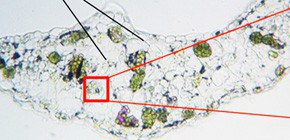
Successful production of plant epidermal cells in internal, non-epidermal tissues
Under the leadership TAKADA Shinobu , Assistant Professor, TAKADA Nozomi , Researcher, and YOSHIDA Ayaka , Graduate Student at the Graduate School of Science, Osaka University, a group of researchers identified a gene related to the formation of the epidermis in plants.
A plant is composed of a variety of cells with different roles. However, how the variety of cells such as epidermal cells and mesophyll cells are formed is unknown. In particular, the genes involved in differentiation of epidermal and mesophyll cells have not been identified.
This group paid attention to a gene Arabidopsis Thaliana Meristem Layer 1 (ATML1) in thale cress. ATML1 was the first transcription factor and was thought to be related to the formation of epidermal cells. In order to examine whether ATML1 had the ability to regulate the formation of the epidermis, this group created transgenic plants that would enable the ATML1 gene to be activated in any of its cells.
As a result, cells with stomata and cirrus were formed in the inner cells in locations where mesophyll cells should have been formed. Mesophyll cell differentiation was repressed and leaves with ectopic patches of transparent cells were formed. It was also found that the transcript level of genes related to epidermis had increased in these transgenic plants. These results demonstrated that ATML1 has the ability to differentiate cells other than epidermal cells into epidermis.
This group's achievement will possibly lead to the clarification of the evolutionary process of plants on land and how the stomata and cuticle are formed in the epidermis of plants.
Abstract
Molecular mechanisms that generate distinct tissue layers in plant shoots are not well understood. ATML1, an Arabidopsis homeobox gene, is expressed in the outermost cell layer, beginning at an early stage of development. The promoters of many epidermis-specific genes, including ATML1, contain an ATML1-binding site called an L1 box, suggesting that ATML1 regulates epidermal cell fate. Here, we show that overexpression of ATML1 was sufficient to activate the expression of epidermal genes and to induce epidermis-related traits such as the formation of stomatal guard cells and trichome-like cells in non-epidermal seedling tissues. Detailed observation of the division planes of these ectopic stomatal cells suggested that a near-surface position, as well as epidermal cell identity, were required for regular anticlinal cell division, as seen in wild-type epidermis. Moreover, analyses of a loss-of-function mutant and overexpressors implied that differentiation of epidermal cells was associated with repression of mesophyll cell fate. Collectively, our studies contribute new information about the molecular basis of cell fate determination in different layers of plant aerial organs.

Figure 1

Figure 2

Figure 3

Figure 4

Figure 5
To learn more about this research, please read the full research report entitled " ATML1 promotes epidermal cell differentiation in Arabidopsis shoots " at this page of the Development website.
Related link :
